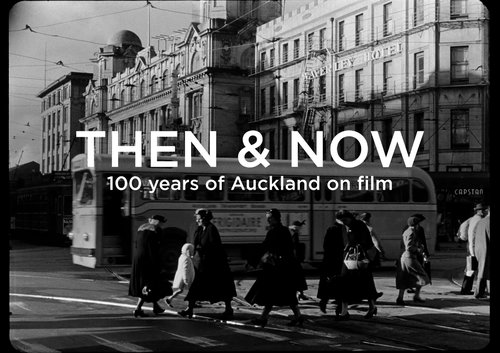
By David Klein
Following the success of our Wellington: Then and Now video in February, we sent our Digital Content Editor Troy Coutts to Auckland to see what’s changed from our archival recordings. He explains how it came together and how the Super City looks today.
To make a ‘then and now’ video, you don’t just go out and film some stuff. There’s a lot of planning and background work to make sure time is well spent and the shots all match up. An experienced camera operator and editor, Coutts knew that the time spent organising everything in advance would be crucial. When he flew from Wellington to Auckland in September, it was a calm and sunny day and the whole project went without a hitch.
“The plan was make the most of the day. The project ended up using shots from ten items in our collection,” says Coutts. “They were chosen to give a good variety of the Super City but also try and appeal to the maximum audience. It’s mostly where people are concentrated.” It was a route through the heart of the city – from the top of Devonport, across the Harbour Bridge and to the airport.
“What people would relate to was a big question to keep in mind,” says Coutts, so the popular, well-peopled and well-filmed areas of the city were chosen. “One exception was Onehunga because I wanted to get a more suburban area. You can see the change from what was once a fairly rural area.”
With the route sorted, there was a pool of potential archive clips to choose from and select shots to recreate. Matching the modern shots with those in the archival films was no easy feat. “A big thing was making sure that there was something of reference that I could use,” explains Coutts. “I needed to know the height and location of the camera and what it’s looking at. Otherwise, buildings look subtly different if the camera is even a metre off. Unfortunately you won’t know until you’re there and see it in person. I was able to move the tripod up and down and try a few different angles to get it as close as possible. When planning, a lot of my reference was Google Street View – I used it heaps.”
It’s interesting to see how things change gradually over time, but sometimes you want to see a ‘blast from the past’. “If it was film from more than 50 years ago,” explains Coutts, “then it’s going to look interesting to see what’s changed because of time. Sometimes it needs something extra though. The trams or sea planes or parades that were more common back then – they’re almost non-existent now.”
Coutts wasn’t alone on the trip. New Zealand filmmaker, musician and artist Greg Page was a huge help. He drove the car, helped organise shots and spoke with people. “Occasionally people get a bit nosy – they want to know why the camera’s out or who you represent. It can be quite distracting explaining to everyone that crosses your path. Having Greg was really helpful and lucky as he’s such a people-person. He talked to them enthusiastically and gave a quick explanation. Everyone seemed very positive when they learnt what we were doing.”
Page knowing the streets made for a great trip, too. Unfortunately not everything went smoothly. “There were a couple of hiccups,” notes Coutts. “There’s a great shot of the opening of the Harbour Bridge in 1959. Since then though, the area where it was filmed has become overgrown with trees. Probably the other issue is that there’s a construction boom. Lots of buildings are covered with scaffolding.”
“Apart from that, I was really happy with all the shots. The finished product turned out great.”